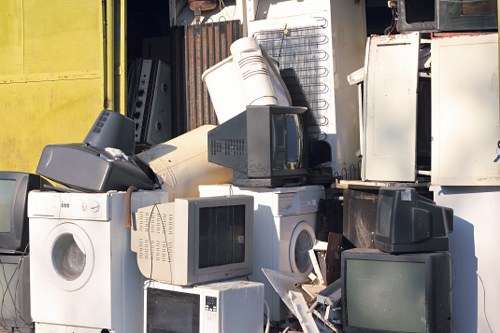Office Clearance in Office Clearance

In the bustling world of business, offices are the beating heart of operations. However, situations arise where office spaces need to be cleared, whether it's due to relocation, downsizing, or liquidation. Office clearance services play a pivotal role in ensuring that this transition is seamless and efficient.
Office clearance involves the systematic removal of furniture, equipment, documents, and other assets from a workspace. This process demands meticulous planning, organization, and execution to minimize downtime and disruption to business activities.
Understanding the intricacies of office clearance is essential for businesses to navigate this often complex task. From choosing the right clearance company to adhering to legal requirements, there are numerous factors to consider.

The Importance of Professional Office Clearance
Opting for professional office clearance services brings numerous benefits. These services are equipped with the expertise and resources necessary to handle large-scale cleanups efficiently.
Professional clearance companies ensure that all items are disposed of responsibly. This includes recycling materials, donating usable items, and safely discarding hazardous waste, thereby promoting environmental sustainability.
Moreover, these companies offer tailored solutions to meet the specific needs of each client. Whether dealing with bulky furniture or sensitive documents, professional clearance services can manage the process with utmost care and precision.

Steps Involved in Office Clearance
Embarking on an office clearance project involves several key steps to ensure success:
- Assessment and Planning: Conducting a thorough assessment of the space to determine the volume and type of items to be cleared.
- Sorting and Categorizing: Differentiating between items to be kept, donated, recycled, or discarded.
- Packing and Removal: Safely packing items and transporting them to designated locations.
- Cleaning and Final Touches: Ensuring the office space is clean and ready for its next phase, whether that's moving to a new location or closing down operations.
Each step requires careful execution to prevent any oversight or damage to valuable assets. Engaging professionals can greatly enhance the efficiency of this process.

Choosing the Right Office Clearance Company
Selecting a reliable office clearance company is crucial for a hassle-free experience. Here are some factors to consider:
- Experience: Look for companies with a proven track record in handling office clearances.
- Reputation: Check reviews and testimonials to gauge customer satisfaction.
- Services Offered: Ensure the company provides a comprehensive range of services, including recycling and disposal.
- Pricing: Obtain detailed quotes to avoid hidden costs and ensure affordability.
- Insurance: Confirm that the company is insured to protect against any potential damages.
Taking the time to research and select the right company can make a significant difference in the overall clearance process.

Legal and Environmental Considerations
When undertaking an office clearance, it's imperative to be aware of legal obligations and environmental responsibilities.
Proper disposal of electronic waste, confidential documents, and hazardous materials is not only a legal requirement but also a moral duty to protect the environment and public health.
Working with a clearance company that adheres to local regulations and environmental standards ensures compliance and fosters sustainability.
Maximizing Efficiency in Office Clearance
Efficiency is key to minimizing downtime during an office clearance. Here are some strategies to enhance the process:
- Early Planning: Start preparations well in advance to allocate sufficient time for each phase.
- Clear Communication: Maintain open channels of communication with your clearance team to address any issues promptly.
- Prioritizing Tasks: Identify and prioritize essential items to ensure critical operations remain uninterrupted.
- Utilizing Technology: Implement software tools for inventory management and tracking progress.
By adopting these practices, businesses can streamline their office clearance and transition smoothly to their next stage.
Common Challenges in Office Clearance
Office clearance projects can encounter various challenges, including:
- Time Constraints: Tight deadlines can add pressure to complete the clearance swiftly.
- Asset Management: Ensuring that valuable items are accounted for and appropriately handled.
- Space Limitations: Navigating the physical constraints of the office layout during removal.
- Employee Coordination: Managing the involvement of staff members to facilitate the clearance process.
Addressing these challenges requires strategic planning and the support of experienced professionals.
Benefits of Timely Office Clearance
Undertaking office clearance in a timely manner offers several advantages:
- Cost Savings: Preventing unnecessary expenses related to prolonged vacancy or storage.
- Enhanced Productivity: Facilitating a swift transition to new office spaces or workflows.
- Legal Compliance: Avoiding fines and penalties by adhering to disposal regulations.
- Environmental Impact: Contributing to sustainability through proper recycling and waste management.
These benefits underscore the importance of not delaying the clearance process.
Post-Clearance Steps
After the completion of an office clearance, certain steps should be taken to ensure everything is in order:
- Inspection: Conduct a thorough inspection of the cleared space to confirm that all tasks have been completed satisfactorily.
- Inventory Check: Verify that all assets have been accounted for and properly managed.
- Final Cleanup: Address any residual debris or mess left behind to leave the space pristine.
- Documentation: Keep records of the clearance process, including receipts for disposed items and documentation of compliance.
These steps ensure that the office space is fully prepared for its next use and that all obligations have been met.
Innovations in Office Clearance Services
The office clearance industry is continuously evolving, incorporating new technologies and methodologies to improve efficiency and effectiveness.
One notable innovation is the use of advanced inventory management systems. These systems allow for real-time tracking of items, ensuring accurate documentation and reducing the risk of loss or misplacement.
Additionally, eco-friendly disposal methods are gaining prominence. Companies are increasingly adopting green practices, such as comprehensive recycling programs and the use of sustainable materials, to minimize environmental impact.
Case Studies: Successful Office Clearances
Examining successful office clearance projects can provide valuable insights and best practices.
For instance, a multinational corporation planning to relocate its headquarters engaged a professional clearance service. The company required the safe removal of sensitive documents and high-tech equipment. The clearance team implemented secure handling protocols and ensured compliance with data protection laws, resulting in a smooth and secure transition.
Another example involves a small business downsizing its operations. The clearance service efficiently managed the removal of furniture and administrative supplies, coordinating donations to local charities and recycling partners. This project showcased the importance of tailored solutions and community-oriented practices.
Cost Factors in Office Clearance
Understanding the cost factors involved in office clearance can help businesses budget effectively.
Several elements influence the overall cost, including the volume and type of items to be cleared, the complexity of the project, and the level of service required. Additional services such as packing, specialized handling, and disposal of hazardous materials may also impact pricing.
To obtain accurate estimates, it's advisable to request detailed quotes from multiple clearance companies. Comparing these quotes can aid in selecting a service that offers the best value without compromising on quality.
Maximizing ROI Through Effective Office Clearance
Investing in professional office clearance can yield significant returns on investment (ROI) by enhancing operational efficiency and preserving valuable assets.
- Asset Recovery: Retrieving and repurposing assets can generate additional revenue or cost savings.
- Space Optimization: Efficient clearance frees up space for new operations, maximizing the use of available resources.
- Brand Image: Demonstrating a commitment to responsible disposal practices can enhance a company's reputation.
- Legal Safeguarding: Ensuring compliance with disposal regulations protects the business from potential legal issues.
By considering these factors, businesses can turn office clearance into a strategic investment.
Future Trends in Office Clearance
The future of office clearance is likely to be shaped by technological advancements and evolving environmental standards.
Automation and artificial intelligence may streamline inventory management and logistics, reducing manual labor and increasing accuracy. Smart systems could anticipate clearance needs based on business growth and turnover, enabling proactive planning.
Furthermore, stricter environmental regulations will drive the adoption of greener clearance practices. Companies will need to prioritize sustainability, integrating eco-friendly methods into their clearance strategies.
Conclusion
Office clearance is a critical process that requires careful planning and execution. By leveraging professional services, businesses can ensure a smooth transition, safeguard assets, and maintain compliance with legal and environmental standards.
As the landscape of office clearance continues to evolve, staying informed about best practices and emerging trends will empower businesses to manage their clearance needs effectively.
Don't let the complexities of office clearance overwhelm you. Contact us today to learn how our expert services can facilitate a seamless and efficient office clearance process for your business.